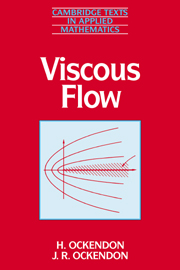4 - Thin films
Published online by Cambridge University Press: 05 June 2012
Summary
In this chapter we consider relatively low Reynolds number flow of a thin film. Such a film may exist between two rigid walls, as in a bearing, or in a droplet, e.g. paint, spreading under gravity on a rigid surface. In either case the geometry of the problem allows us to simplify equation (3.2) in a way that is similar to the technique used to derive boundary layer theory in Chapter 2. The differences are that the order of magnitude of the width of the thin layer is dictated by the data of the problem and, since the layer is confined geometrically, there is no need to match with an outer flow.
Lubrication theory for slider bearings
The simple observation that a sheet of paper can slide across a smooth floor shows that a thin layer of fluid can support a relatively large normal load while offering very little resistance to tangential motion. More important mechanical examples occur in the lubrication of machinery and this motivates the study of slider bearings. A slider bearing consists of a thin layer of viscous fluid confined between nearly parallel walls that are in relative tangential motion.
A two-dimensional bearing is shown in figure 4.1 in which the plane y = 0 moves with constant velocity U in the x-direction and the top of the bearing (the slider) is fixed.
- Type
- Chapter
- Information
- Viscous Flow , pp. 64 - 82Publisher: Cambridge University PressPrint publication year: 1995
- 1
- Cited by

